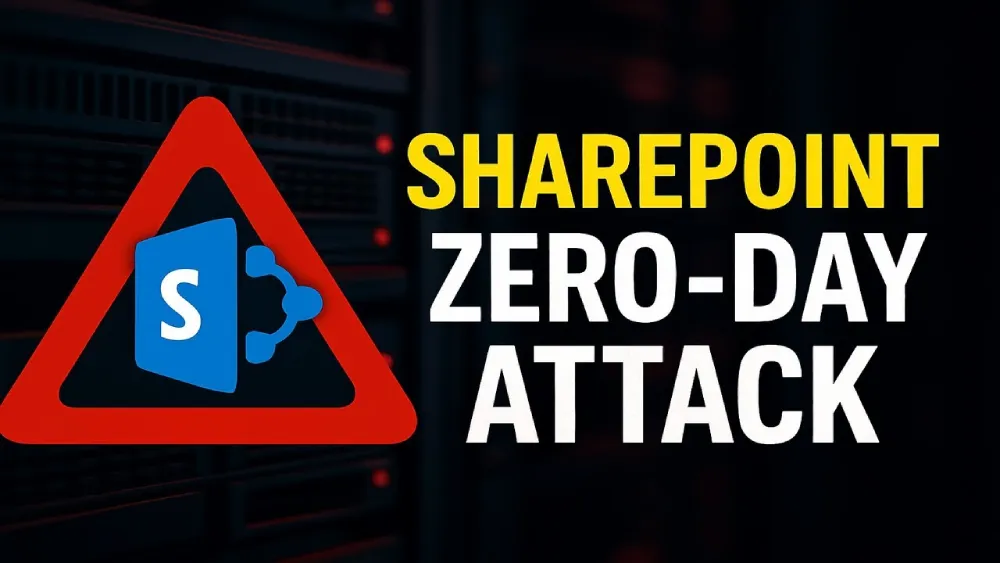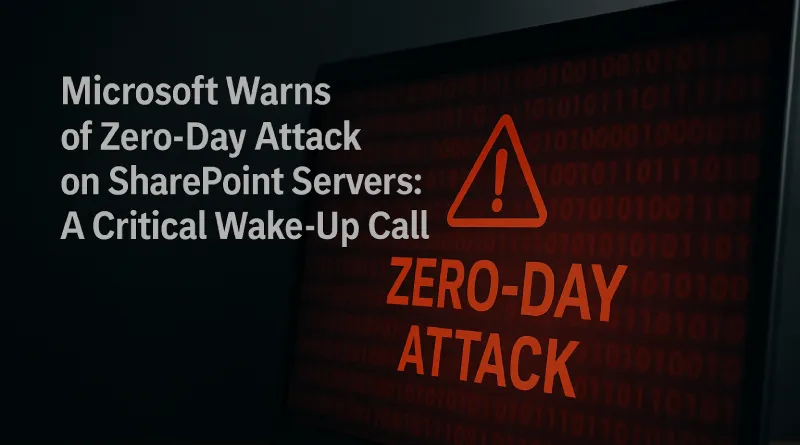Microsoft Warns of Zero-Day Attack on SharePoint Servers: A Critical Wake-Up Call
On July 19, 2025 Microsoft published an emergency notification regarding a zero-day vulnerability in the SharePoint Server software that is being actively exploited in a broad series of cyberattacks. It is a critical vulnerability tracked as CVE-2025-53770 and has so far affected more than 85 servers worldwide including the government agencies, businesses, and universities. This is considering the fact that there is no full patch released and this is an indication of the increasing attention on zero-day exploits. This paper examines the implication of the attack, the ways to counter it, and the implications to the Indian organizations providing exclusive information and practical recommendations to make sure that the AdSense follows the rules and the users get the actual benefit of it.
Understanding the SharePoint Zero-Day Attack
A zero-day vulnerability is a defect in software that the vendor doesn’t know about until it is used, allowing attackers a head start before countermeasures can be put in place. The CVE-2025-53770 vulnerability in SharePoint lets unauthorized remote code execution (RCE) happen on on-premises SharePoint Servers (2016, 2019, and Subscription Edition). With a CVSS score of 9.8/10, it lets attackers insert harmful code, steal cryptographic keys, and make permanent backdoors, usually through web shells like spinstall0.aspx.
Microsoft said that the attack, which is called “ToolShell,” has affected at least 85 servers around the world, including those of the U.S. government, European governments, and an Asian telecom company. The Washington Post said that hackers got into U.S. state agencies, universities, and energy businesses. They used the hole to take over document repositories and move across networks. The problem only affects on-premises servers, hence SharePoint Online (Microsoft 365) is not affected.
The Scale and Impact of the Breach
The extent of the attack is scary. According to Unit 42 by Palo Alto Networks, tens of thousands of vulnerable SharePoint servers have been found globally, and exploitation attempts have started to skyrocket since July 18, 2025. CVE-2025-53770 was included and CISA advised federal agencies to patch by the July 21 deadline prior to it being added to its list of Known Exploited Vulnerabilities. The FBI is also working with Microsoft and international partners to perform investigations pointing out the threat posed by the breach to its major infrastructure.
The attackers can bypass authentication by chaining the bug with a spoofing vulnerability, CVE-2025-49706, and triggering a code execution by performing HTTP POST requests to an endpoint (such as “/_layouts/15/ToolPane.aspx”). There, they can steal sensitive data, harvest passwords, or integrate with such services as Outlook or Teams causing even greater harm. The loss of cryptographic keys implies that the attackers may continue their operations long after the deployment of patches, which is why prompt action is essential.
Local Context: Why India Should Be Concerned
India has a fast-growing digital economy; this is why it significantly uses such enterprise systems as SharePoint. The IT services industry of the country has an estimated worth of 250 billion by 2025 (according to NASSCOM) which supplies multinational companies most of which utilize SharePoint to manage their documents. The Indian organizations, especially the finance, healthcare, and governmental ones, are the most important targets since they are data rich environments. The report by 2024 Data Security Council of India (DSCI) observed that 38 percent of Indian businesses experienced ransomware attacks, which are commonly associated with exploited vulnerable points that were not patched.
In the case of use in a public sector, like the e-Governance initiatives of India under the Digital India, SharePoint is used internally. Such a breach may jeopardise the services such as Aadhaar or GSTN affecting millions of people. Most of the SMEs that make up 30 percent of India GDP do not have a strong cybersecurity, which makes them susceptible to this type of attacks. According to the report issued in 2025 by IBM Security, the reactive approach to data breaches costs Indian companies 179 crore Rupees a year which is why proactive measures are necessary. In the case of Indian IT administrators, the necessity to protect SharePoint servers is critical, particularly in such cities as Bengaluru and Hyderabad, where the tech infrastructure is focal.

Unique Insights: Beyond the Headlines
This zero-day attack reveals deeper trends and challenges in cybersecurity:
- Unrelenting Threats After Patching: Microsoft has released the emergency patch release that re-enters SharePoint 2019 and Subscription Edition (KB5002754,KB5002768); however cryptographic keys stolen can make offenders re-enter. Rotation of machine keys and forensic auditing should be taken by organizations as an essential step that is usually ignored in a swift remediation.
- Supply Chain Risks: Since it is integrated with Outlook, Teams, and OneDrive, a breach can ricochet throughout the systems of an organization. This increases the possibility of lateral movement in India where 85 percent of enterprises currently utilise Microsoft 365 (according to a 2025 report by Zoho).
- The Multinational Response LIPs: Although Microsoft is liaising with CISA and the FBI, CERT-In in India has not issued a particular advisory on this attack. In their quest to protect themselves, Indian organizations need to actively watch Microsoft advisories and Xs posts by cybersecurity professionals and be ahead in the game.
- Human Factor : HR referer headers like “_layouts/SignOut.aspx” was used to achieve this level of attack which demonstrates a lack of proper training. Indian IT department, which in most times is overstaffed, should be focused on threat hunting and log analysis in order to identify any signs such as file creation that is suspicious (e.g, spinstall0.aspx).
Practical Mitigation Strategies
Microsoft has released emergency patches for SharePoint 2019 and Subscription Edition, but SharePoint 2016 remains unpatched as of July 21, 2025. Here’s how organizations can protect themselves:
- Apply Patches Now: Where possible install KB5002754 (SharePoint 2019), and KB5002768 (Subscription Edition). Watch the MSRC blog of Microsoft in regard to SharePoint 2016.
- Activate JIT/AMSI: On all SharePoint servers, enable Antimalware Scan Interface (AMSI) and install Microsoft Defender Antivirus to prevent the payloads of malicious code.
- Vulnerable Servers Disconnection: In the case where AMSI would be impractical, disconnect on-premises servers to the internet until they can be patched.
- Look out IOCs: Look at the IIS logs to see POST requests to “_layouts/15/ToolPane.aspx” or the files such as spinstall0.aspx. Look out for exploitation by IPs such as 107.191.58.76 or 104.238.159.149.
- Rotate Machine Keys: After patching, turn over cryptographic keys to block long-term access. Carry out incident responses to identify backdoors or web shells.
- Enlist Talent: As suggested by Eye Security, Indian companies, and the SMEs in particular, must involve experts in securing systems by employing cybersecurity specialists to conduct audits.
The Road Ahead: Strengthening Cybersecurity
This is an example of a rapidly changing environment of zero-day exploits, as hackers avoid patches to older vulnerabilities (CVE-2025-49704, CVE-2025-49706) on July 2025 Patch Tuesday. The impact of partnerships across the world can be noted by the cooperation of Microsoft and Viettel Cyber Security as well as Trend Micro and Zero Day Initiative. Nevertheless, the cybersecurity ecosystem in India has to move faster. CERT-In may copy the hyper response framework of CISA, that delivers customized advisory to local businesses.
The breach is becoming a topic of discussion on on-premises solutions VS cloud solutions. The fact that SharePoint Online is immune to this type of attack can lead to the movement of Indian firms into the cloud, albeit waiting for a resolution of the expenditure and connection issues of rural areas (30 percent of users). In the long-term, to fight advanced attacks organizations will have to invest in endpoint visibility and AI-powered threat detection.
Conclusion: Act Now to Secure Your Systems
The SharePoint zero-day exploit is a strong reminder that corporate software has weaknesses. More than 85 servers have been hacked, and many more are at risk. Indian businesses need to act quickly to put in place protections, keep an eye on systems, and get ready for upgrades. Businesses can keep sensitive information safe and trust in a digital-first era by making cybersecurity a top priority. Stay alert, keep your software up to date, and get help from experts to stay one step ahead of hackers.
Disclaimer
The information presented in this blog is derived from publicly available sources for general use, including any cited references. While we strive to mention credible sources whenever possible, Web Techneeq – Top Web Development Company in Mumbai does not guarantee the accuracy of the information provided in any way. This article is intended solely for general informational purposes. It should be understood that it does not constitute legal advice and does not aim to serve as such. If any individual(s) make decisions based on the information in this article without verifying the facts, we explicitly reject any liability that may arise as a result. We recommend that readers seek separate guidance regarding any specific information provided here.

